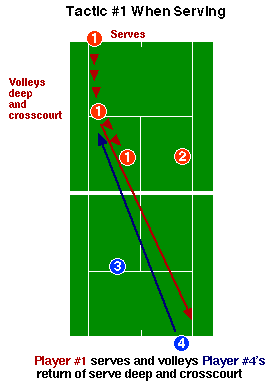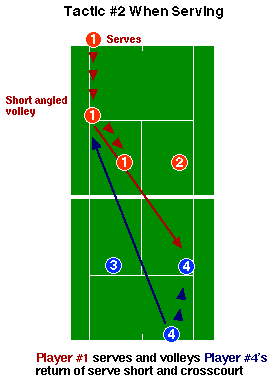<% ns_puts [nsv_get mkm_includes mkm_oldContentHeader_inc] %>
Strategy Lesson
of the Week
Doubles: How to Play Against a One Up/One Back Team
Strategy Question of the Week
How do we play against a team that plays one up (at the net) and one back
(at the baseline)?
Answer
(Note: This is a basic doubles lesson aimed at beginning and intermediate
club doubles players. For the sake of readability, it is assumed that these
are two female doubles teams).
First and foremost, your team needs to determine your own style of play
before you look over the net and decide how to play your opponents. Are
you a team that plays one up and one back like your opponents or are you
a team that tries to come in every chance you get? Once you have determined
your own style of play then and only then are you ready to know how to face
the opposition.
In Part 2 of this answer, we'll look at the strategy if you and your
partner like to come to the net. Part 2a focuses on tactics to use when
your team is serving. Next week, part 2b will focus on tactics for the receiving
doubles team.
How to Play Against a One Up/One Back Team--
When Your Team Likes To Come to the Net
(Tactics for the Serving Team)
By Monty Basynat, TennisONE Editor
If your doubles team likes to seize control of the match by coming into
the net, you have definite advantages over teams that play one up, one back.
In general, you are in a much better position to volley all balls hit at
you, which gives your team many more opportunities for a variety of forcing
and winning shots. Your opponents' one up/one back positioning, on
the other hand, will make them hit more defensive groundstrokes
and lobs as well as create spacing problems which you and your partner can
exploit with your superior positioning closer to the net.
So the answer to the question in the title is to be found in all the smart
ways to come to the net. I've broken these down into five tactics for coming
to the net.
One cautionary note: All the positioning of the players in the doubles lessons
shown here will change depending on a variety of factors, including your
shot velocity and placement, your opponents' positioning, as well as your
opponents' strengths and weaknesses. In other words, there is no one correct
position during the dynamic movement and positioning required in doubles.
In particular, how close your team closes to the net and how tightly
you guard your alleys depends on a variety of factors you must assess and
respond to instantly.
 If you can serve
and volley, this diagram lays out the basic tactic for coming into the net
on your serve. On the serve and volley, you normally you make your first
volley around the service line. (Naturally, you should be taking a split
step (see Dan Leon's lesson) before making
your first volley.) But where do you play that volley? The safest
and most reliable tactic here is to take your opponent's return of serve
(as shown by Player #2) and volley this ball deep and
crosscourt. This does two things. First, a deep volley gives you
more time to close to the net, as Player #1 has done here. Secondly, a crosscourt
volley keeps the volley safely away from Player #3 who should be looking
for any floating return across the middle of the court. Note as well that
your partner (Player #2) has seen your crosscourt volley and shifted over
to cover her alley.
If you can serve
and volley, this diagram lays out the basic tactic for coming into the net
on your serve. On the serve and volley, you normally you make your first
volley around the service line. (Naturally, you should be taking a split
step (see Dan Leon's lesson) before making
your first volley.) But where do you play that volley? The safest
and most reliable tactic here is to take your opponent's return of serve
(as shown by Player #2) and volley this ball deep and
crosscourt. This does two things. First, a deep volley gives you
more time to close to the net, as Player #1 has done here. Secondly, a crosscourt
volley keeps the volley safely away from Player #3 who should be looking
for any floating return across the middle of the court. Note as well that
your partner (Player #2) has seen your crosscourt volley and shifted over
to cover her alley.
 Volleying the return of serve deep
and crosscourt is an excellent tactic for coming to the net, but a short,
angled volley is also a good tactic--especially if your opponent (Player
#4) likes to play from behind the baseline. A short angled volley will force
Player #4 to take several steps in to a hit what is generally a low, sliding
ball. If your angled volley sits up, your partner (Player #2) will have
to guard the alley more closely, as Player #4 will have the opportunity
to take your high ball and drive it down Player #2's alley.
Volleying the return of serve deep
and crosscourt is an excellent tactic for coming to the net, but a short,
angled volley is also a good tactic--especially if your opponent (Player
#4) likes to play from behind the baseline. A short angled volley will force
Player #4 to take several steps in to a hit what is generally a low, sliding
ball. If your angled volley sits up, your partner (Player #2) will have
to guard the alley more closely, as Player #4 will have the opportunity
to take your high ball and drive it down Player #2's alley.
Send in Your Strategy Questions to TennisONE
If you think you have a good TennisONE Strategy Question, please send an
email to: question@tennisone.com.
<% ns_puts [nsv_get mkm_includes mkm_oldContentFooter_inc] %>
 If you can serve
and volley, this diagram lays out the basic tactic for coming into the net
on your serve. On the serve and volley, you normally you make your first
volley around the service line. (Naturally, you should be taking a split
step (see Dan Leon's lesson) before making
your first volley.) But where do you play that volley? The safest
and most reliable tactic here is to take your opponent's return of serve
(as shown by Player #2) and volley this ball deep and
crosscourt. This does two things. First, a deep volley gives you
more time to close to the net, as Player #1 has done here. Secondly, a crosscourt
volley keeps the volley safely away from Player #3 who should be looking
for any floating return across the middle of the court. Note as well that
your partner (Player #2) has seen your crosscourt volley and shifted over
to cover her alley.
If you can serve
and volley, this diagram lays out the basic tactic for coming into the net
on your serve. On the serve and volley, you normally you make your first
volley around the service line. (Naturally, you should be taking a split
step (see Dan Leon's lesson) before making
your first volley.) But where do you play that volley? The safest
and most reliable tactic here is to take your opponent's return of serve
(as shown by Player #2) and volley this ball deep and
crosscourt. This does two things. First, a deep volley gives you
more time to close to the net, as Player #1 has done here. Secondly, a crosscourt
volley keeps the volley safely away from Player #3 who should be looking
for any floating return across the middle of the court. Note as well that
your partner (Player #2) has seen your crosscourt volley and shifted over
to cover her alley. Volleying the return of serve deep
and crosscourt is an excellent tactic for coming to the net, but a short,
angled volley is also a good tactic--especially if your opponent (Player
#4) likes to play from behind the baseline. A short angled volley will force
Player #4 to take several steps in to a hit what is generally a low, sliding
ball. If your angled volley sits up, your partner (Player #2) will have
to guard the alley more closely, as Player #4 will have the opportunity
to take your high ball and drive it down Player #2's alley.
Volleying the return of serve deep
and crosscourt is an excellent tactic for coming to the net, but a short,
angled volley is also a good tactic--especially if your opponent (Player
#4) likes to play from behind the baseline. A short angled volley will force
Player #4 to take several steps in to a hit what is generally a low, sliding
ball. If your angled volley sits up, your partner (Player #2) will have
to guard the alley more closely, as Player #4 will have the opportunity
to take your high ball and drive it down Player #2's alley.